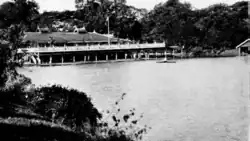Kandawgyi Palace Hotel
The Kandawgyi Palace Hotel was a five-star hotel and historical landmark overlooking the Kandawgyi Lake in Yangon, Myanmar. The hotel caught fire on the morning of Thursday, 19 October 2017 and was destroyed.
| Kandawgyi Palace Hotel | |
|---|---|
 The Kandawgyi Boat Club, circa 1934 | |
| General information | |
| Type | Hotel |
| Architectural style | Traditional Southeast Asian Palace |
| Location | Kan Yeik Tha Road and Kandawgyi Lake, Yangon |
| Coordinates | 16°47′41″N 96°09′43″E |
| Construction started | 1934 |
| Completed | 1993 |
| Destroyed | October 19,2017 |
| Owner | Tay Za |
| Management | Htoo Group of Companies |
| Design and construction | |
| Developer | Baiyoke Group of Hotels |
History
The Kandawgyi Palace Hotel, built in 1934, started out as a two-story, red-brick building to house the Rangoon Rowing Club. It was a regular retreat for British officers who occupied British Burma at the time. It was then used by the Japanese as a welfare department during their occupation during World War II. After the war and when Burma had gained independence, the property became the National Biological Museum in 1948. The site first began operating as a hotel in 1979, when the Ministry of Hotels and Tourism took over. The hotel featured 10 bungalows made of teak. They were eventually replaced in 1993 by a larger lakeside building resembling traditional Southeast Asian architecture.[1] The hotel was bought out by the Htoo Group of Companies, which was founded by Tay Za, a controversial Burmese tycoon who was closely linked to the country's former head of state, Than Shwe.[2]
Fire of 2017
At 3:15 in the morning of Thursday, 19 October, 2017, a devastating fire broke out. The cause was believed to have been an electrical fault. The fire was fed by gas canisters that burst from the boiler room. Eighty fire trucks were brought in to try to control the blaze,[3] but the teak building was gutted. The hotel had 96 occupied rooms with a total of 141 guests. One man and a lady perished, a firefighter was treated for smoke inhalation, and a guest was treated after jumping from one of the hotel's upper windows.[4]
References
- "Htoo Hospitality, History of The Kandawgyi Palace". Retrieved 20 October 2017.
- "MSN, Massive fire guts iconic Myanmar hotel". Retrieved 20 October 2017.
- "International Business Times: WATCH: Firefighters In Yangon, Myanmar, Battle Fire At Kandawgyi Palace Hotel". Retrieved October 20, 2017.
- "The New York Daily News: Fire rips through luxury Myanmar hotel, 1 body recovered". Retrieved October 20, 2017.